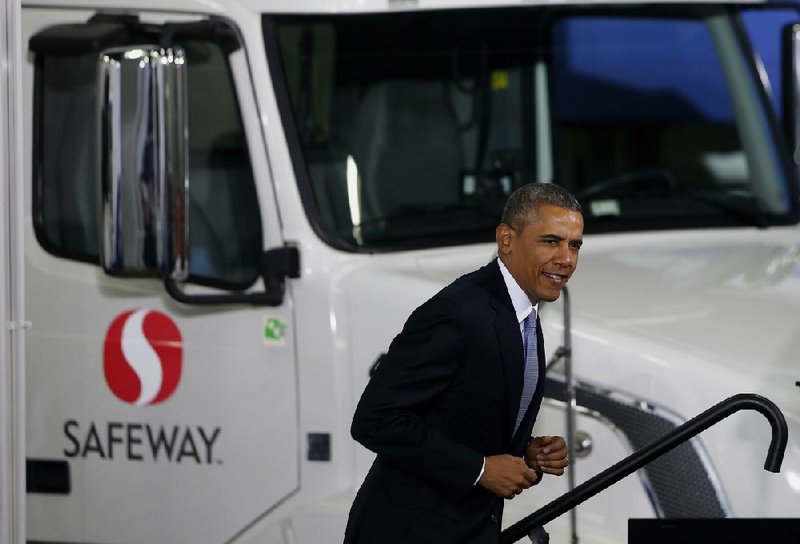WASHINGTON - President Barack Obama directed his administration Tuesday to issue the next round of fuel-efficiency and greenhouse-gas standards for medium- and heavy-duty vehicles by March 2016.
Obama said the action would benefit the economy through lower costs for consumers and development of new technology while also enhancing U.S. energy security.
The new standards will mean “thousands of dollars in savings every year” for truck operators, Obama said at a Safeway Inc. distribution center Tuesday in Upper Marlboro, Md., where he was highlighting the grocery chain’s efforts to improve truck-fleet efficiency.
The higher mileage standards are part of Obama’s strategy for energy security and dealing with climate change, the White House said in a statement. The administration previously set a standard requiring automakers to double average fuel economy of their fleets to 54.5 miles per gallon by 2025.
Safeway participates in a partnership with the Environmental Protection Agency that includes investing in trucks that get better mileage, in part through improved aerodynamics, tires with low rolling resistance and larger capacity trailers, according to the White House.
As part of Tuesday’s action, the EPA and the Department of Transportation’s National Highway Traffic Safety Administration are being directed to to issue a Notice of Proposed Rulemaking by March of next year.
Heavy-duty vehicles account for about a quarter of U.S. on-road fuel use and greenhouse-gas emissions from transportation, according to the administration. Scientists have tied greenhouse-gas emissions to climate change.
Industry groups were generally supportive of the new standards, and the collaboration between the government and manufacturers.
“The development of these new standards continues to demonstrate meaningful progress between government and industry,” Douglas Stotlar, chief executive officer of Con-way Inc., the third-biggest U.S. freight company, said in an emailed statement. “This collaborative approach will result in realistic, achievable goals and an effective regulatory framework.”
Con-way is part of an informal coalition representing truck fleet owners, engine manufacturers and suppliers.
The American Trucking Association urged the government to proceed cautiously. Association President Bill Graves said his group supported an earlier round of efficiency standards and “hopes the administration will set forth a path that is both based on the best science and research available and economically achievable.”
Tuesday’s announcement followed the first-ever fuel-economy rules for U.S. truck makers three years ago, which sought to improve efficiency by about 20 percent by 2018, saving $50 billion in fuel costs over five years and decreasing carbon-dioxide emissions.
The administration’s plan, which also covered city buses and garbage trucks, was projected to save 530 million barrels of oil over the lifetime of the vehicles covered by the standards.
The next round of regulations, for the 2018 model year and beyond, is expected to force the industry to deploy technology more aggressively. Besides engine and transmission improvements, trucking firms may have to adopt more aerodynamic trailers, adding skirts at the bottom or tails on the end to reduce wind resistance.
Like the first truck-efficiency rules, the next rules are supposed to be negotiated in close consultation with trucking firms, engine manufacturers, environmental groups and other stakeholders, according to a White House fact sheet. The Environmental Protection Agency and the Transportation Department will consult with California regulators so there’s a single national standard, the fact sheet said.
Frances Beinecke, president of the Natural Resources Defense Council, said stricter standards would cut carbon emissions and reduce costs for consumers and truck owners.
“Setting the bar higher for trucks will further encourage innovation in the industry,” Beinecke said in a statement. “This is a win-win for the environment and the economy.” Information for this article was contributed by Roger Runningen of Bloomberg News.
Front Section, Pages 3 on 02/19/2014

